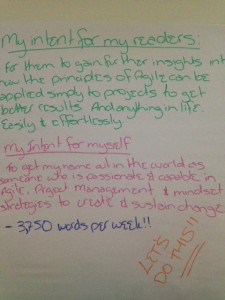Dealing with Resistance
Have you ever worked on a project and you experienced stakeholders resisting the change that you were driving? It might be as big as them resisting the new systems and processes you are bringing in because they will have to change everything about how they work and it’s just too much. It might be that they hate the new background screen on their PC. It doesn’t matter. The point is they are resisting. And it makes our jobs as Project Practitioners HARD. Now, there are all sorts of tactics on how to deal with these people and I’m sure you can come up with more than I can. The common ones:
- Take them out for coffee and look to understand what might be underneath their resistance
- Ask them how they would want it instead (who knows, they might come up with a better idea!)
- Escalate to their boss (use only in emergency)
Now… What about if… Wait for it… The resistance is coming from… You…
Resistance from Within
It’s hard to believe that such change loving, progressive people such as Project Managers resist change, but we DO. All the time. While we might be happily driving our own project forward, we could be resisting other change. Which WILL have an impact on our own projects.
This thought came to me as I was writing the book. Have you noticed that the next chapter is a bit slow in coming? Well, it’s because I have been experiencing a bit of resistance myself. FROM myself. Hard to believe, but true. Words were making their way to the pages more slowly, time was shrinking, allowing less time to write, the weather is getting colder (what does that have to do with anything? Hmmm…). And I sensed it. All of these things are indicators of resistance. I’m not going to go so far and call it procrastination. In fact, I would rather not give it a name. A names gives something power, and we don’t want that.
Why Resist?
Ironically, signs of resistance came up as I was writing Know your Why. Here I talk about how important it is to know your purpose so you are better able to articulate and get excited about your project’s purpose. Otherwise, it’s hard to define what your project (and life!) is all about. And it got me asking two questions – firstly, why am I resisting? The answer was simply: I don’t know – perhaps I have lost sight of my Why. With that in mind my second question was: what is my Why for writing this book? I worked out I had two intentions – one for my readers and one for me.
My intent for my readers is for them to gain further insights into how the principles of Agile can be applied simply to projects to get better results. I also want my readers to be able to apply these principles and simple techniques to anything in life, easily and effortlessly.
My intent for myself (this was harder) is to get my name out in the world as someone who is passionate and capable in the areas of Agile, project management and mindset strategies to create and sustain change.
What to do about it
If we can’t deal with resistance from ourselves, how can we possibly expect to deal with difficult people? Simply asking why you might be resisting something is the best way to start. It’s a great way of opening up a communication channel with your unconscious mind. And it doesn’t matter if you don’t know. Ask and listen for what comes back – take yourself out for a coffee if that helps. If you don’t know, then the chances are you need to connect with your Why. Because, the thing is, you have not changed as a person between the time you started whatever it is you started and the time you first experience resistance. And the same goes for your stakeholders. They haven’t suddenly turned into evil vampires that are set on ruining your life (although it may seem like it at times…). It simply must be something else.
Reconnect with your Why
Your Why might have changed a bit. You may have forgotten it. I had written mine down but it was in a document on my computer. So I wrote it up on butchers paper. See, here it is…
And then do something…
I wish that every challenge could be solved with writing something in coloured textas on butchers paper. Looking around my study, I have conquered may challenges! So, I committed to a weekly word count. Because, to be honest, writing for just an hour every day doesn’t always work for me – I just get started and the hour is up. So, I allow a few hours on a number of nights as well as weekends with the intention of writing 3,750 words per week. And keeping track.
Let’s do this!

